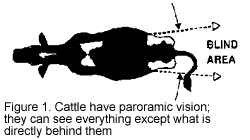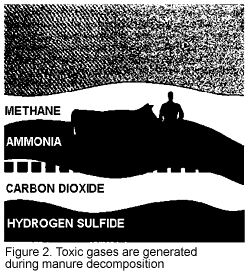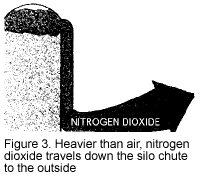Few farmers view livestock as a source of danger. Yet animal-related accidents cause numerous deaths and serious injuries each year. A recent National Safety Council study ranked beef cattle farms second and dairy operations third among all farming enterprises in injuries per hours of work. Seventeen percent of all farm injuries involved animals. This equaled the percentage of injuries caused by farm machinery.
Removing hazards brings you one step closer to a safe work environment. Whether you are operating equipment or working with animals, taking a few precautions and observing safety rules can save you precious time, prevent injury, or even save your life.
GENERAL CONSIDERATIONS
 Anyone who works with livestock knows each animal has its own
personality. Animals sense their surroundings differently than
humans. Their vision is in black and white, not in color. They
also have difficulty judging distances. And differences exist
between the vision of cattle, swine and horses. For example,
cattle have close to 360-degree panoramic vision (Figure 1).
A quick movement behind cattle may "spook" them.
Anyone who works with livestock knows each animal has its own
personality. Animals sense their surroundings differently than
humans. Their vision is in black and white, not in color. They
also have difficulty judging distances. And differences exist
between the vision of cattle, swine and horses. For example,
cattle have close to 360-degree panoramic vision (Figure 1).
A quick movement behind cattle may "spook" them.
Animals have extremely sensitive hearing and can detect sounds that human ears cannot hear. Loud noises frighten animals, and research proves that high-frequency sounds actually hurt their ears. These factors explain why animals are often skittish and balky, particularly in unfamiliar surroundings.
Watching animals for signs of aggressiveness or fear alerts you to possible danger. Warning signs may include raised or pinned ears, raised tail or hair on the back, bared teeth, pawing the ground or snorting.
Although handling methods may vary greatly for different types of livestock, there are some generally accepted rules for working with any animal:
FACILITIES
Tripping hazards such as high door sills, cluttered alleyways and uneven walking surfaces can cause serious injury and a considerable amount of lost work time. Studies have found that falls account for 18 percent of all animal-related accidents.
Concrete floors are best for livestock. The finish on concrete floors should be roughened to prevent slips under wet conditions. High traffic areas, such as alleyways, should be grooved. Floors should allow water to drain easily. Slatted floors often are used to keep animals dry in a confinement system.
Fencing and gates should be strong enough to contain crowded livestock. A variety of materials are available, but the key is strength and durability. A protruding piece of lumber, a nail or a bolt can cause painful and infectious injuries. If backed or pushed into, one of these objects can cause a serious back injury.
Alleys and chutes should be wide enough to allow animals to pass, but not wide enough to allow them to turn around. A width of 30 inches is recommended for a cow-calf operation. For cattle in the range of 800 to 1,200 pounds, a 26-inch width is recommended. Solid wall chutes, instead of fencing, will lower the number of animals that balk in the chute.
Lighting should be even and diffused. Bright spots and shadows tend to make animals more skittish, especially near crowding or loading areas. Animals move more readily from dark areas into light, but avoid layouts that make them look directly into the sun.
Handling equipment can speed up livestock confinement work operations, reduce time and labor requirements, cut costs, and decrease the risk of injury.
ANIMAL HEALTH AND HYGIENE
Ventilation should minimize dust. Various molds that can cause respiratory as well as digestive problems may be present in feed. All feeds should be carefully checked before they are fed to livestock. Deal only with reliable feed dealers and have suspect feed tested.
ANIMAL DISEASES AFFECTING PEOPLE
Rabies Rabies is a deadly virus that affects the central nervous system. It can be transmitted by saliva from an infected animal through a bite, open wound or sore. Although widespread pet inoculation has greatly reduced the threat of rabies, rural people are at greater risk due to their proximity to wild animals. A veterinarian should be called to examine animals observed acting abnormally. Seek immediate medical attention if you are bitten by an animal that you suspect is rabid.
Lyme Disease (LD)Lyme Disease (LD), while only a remote possibility in Missouri, is another potential threat. Although the tick species known to transmit LD are not present in the state, the organisms that cause LD have been found in the Lone Star tick, which is found in Missouri. It is not known at present whether this tick transmits LD to humans. It may transmit LD to animals, but is known to do so only in its nymphal stage when it is usually found on rodents, birds and feral animals such as deer.
If LD occurs, its symptoms may develop within 2 to 30 days of the tick bite. A small red bump appears near the bite and enlarges into a spreading red ring. This is followed by a general sickness, including fever, chills, headaches and backache. Some may experience palpitations, dizziness and shortness of breath.
LD responds well to antibiotics in its early stages, but if left untreated, it may advance into a chronic stage involving rheumatoid arthritis or cardiac problems.
Brucellosis (Bands Disease)Brucellosis (Bangs Disease) affects cattle, goats and swine. It can be transmitted to people in unprocessed milk, infected carcasses, or by an aborted fetus or afterbirth from an affected animal. Good sanitation practices reduce the chances that herds will be infected. Animals should be tested periodically for this disease.
Trichinosis Trichinosis, caused by tiny parasites, can be painful and sometimes fatal to humans. It is transmitted by consumption of uncooked or partially cooked pork. Trichinosis has nearly been eradicated in North America. Thorough cooking is the best prevention.
Salmonella Salmonella organisms are found in poultry and in wild and domestic animals. They can be transmitted to people through contaminated food or water. The disease can cause severe gastrointestinal distress and fever. Prevention includes proper storage and cooking of animal-derived foods. Good sanitation procedures when handling food reduce the risk of salmonella poisoning.
Other zoonoses also exist. However, preventive measures such as keeping animal facilities clean, testing and immunizing, and using sanitary practices in handling animals and their products minimize the danger.
MANURE PIT GASES
 Toxic gases, especially in confined spaces such as manure pits,
silos and grain bins, can pose hazards to humans and animals
(Figure 2). Four gases of major concern can be found in manure
pits. They are hydrogen sulfide (H2S), ammonia (NH3),
carbon dioxide (CO2) and methane (CH4).
Toxic gases, especially in confined spaces such as manure pits,
silos and grain bins, can pose hazards to humans and animals
(Figure 2). Four gases of major concern can be found in manure
pits. They are hydrogen sulfide (H2S), ammonia (NH3),
carbon dioxide (CO2) and methane (CH4).
The primary health hazards of these gases are:
Characteristics
Hydrogen sulfide:Ammonia:
Carbon dioxide:
Methane:
PREVENTION
SILO GASES
 Grain, particularly corn, can accumulate high amounts of nitrates.
During the first 24 to 48 hours of fermentation, significant
amounts of nitrogen dioxide (NO2) can be released (Figure 3).
When this gas is inhaled by silo workers, it can cause a severe
chemical pneumonia known as "silo filler's disease."
Grain, particularly corn, can accumulate high amounts of nitrates.
During the first 24 to 48 hours of fermentation, significant
amounts of nitrogen dioxide (NO2) can be released (Figure 3).
When this gas is inhaled by silo workers, it can cause a severe
chemical pneumonia known as "silo filler's disease."
Nitrogen dioxide is one of the most hazardous lung irritants. It has a pungent, sweetish odor, even in low concentrations of 5 parts per million (ppm). It has a reddish-brown color, visible only when concentrations reach a dangerous level (75-150 ppm). It is heavier than air and can settle at the bottom of enclosed spaces.
Any concentration over 25 ppm can be hazardous. The effect on the lungs is often so subtle that the victim may not realize the serious nature of the exposure until too late. Inhalation of 50 to 75 ppm for 30 to 60 minutes can cause bronchitis; 50 to 100 ppm causes chemical pneumonia; 150 to 200 ppm, a severe fibrosis type of pneumonia; 300 to 400 ppm, severe lung damage, fatal in 2 to 10 days; over 500 ppm, acute pulmonary edema, fatal in less than 48 hours.
PREVENTION
For information about grain storage, see MU publication G01969, Safe Storage and Handling of Grain.
DUSTS
Some dust carries antigens that cause severe irritation to the respiratory tract and lungs. This often results in lung damage. The most common form is known as "farmer's lung." It results from breathing moldy forage or grain, normally hay. Farmer's lung is one of the most disabling diseases among dairy farmers.
Farmer's lung symptoms often are not noticed until several hours after exposure to the dust. Symptoms often are mistaken for bronchitis or pneumonia. If the disease is not diagnosed early, irreversible lung damage and sometimes death can result.
Farmer's lung will limit the amount of work a farmer can do because shortness of breath will require frequent rest periods.
"Nuisance dust" is the term for other forms of dust that are often inhaled while working with livestock. Breathing dusty air of this type for long periods will cause areas of your lungs to become hardened and inelastic, and your capacity to take in needed oxygen will be reduced. Furthermore, your susceptibility to respiratory diseases like pneumonia may increase.
PREVENTION
PERSONAL PROTECTIVE EQUIPMENT
If you must enter a manure pit or silo without a self-contained breathing apparatus, turn on all forced ventilation equipment for a minimum of 30 minutes.
Wear a harness or tie a rope around your waist and have at least one person holding the lifeline. If you are overcome by the gas, this lifeline is your only means of rescue without endangering other people.
A self-contained breathing apparatus is recommended, but its high cost may make it impractical to have this equipment readily available on most farms.
SAFETY REMINDERS FOR LIVESTOCK HANDLING
Publication #: GO1931
This document is published by Missouri University Extension, the University of Missouri-Columbia, Columbia, MO 65211. Publication date: October 1993. Partial funding for this guide sheet was provided by the University of Missouri-Columbia/National Institute for Occupational Safety and Health Cooperative Agricultural Promotions Agreement.
David E. Baker and Rusty Lee, Department of Agricultural Engineering, University of Missouri-Columbia, Columbia, MO 65211.
Disclaimer and Reproduction Information: Information in NASD does not represent NIOSH policy. Information included in NASD appears by permission of the author and/or copyright holder. More